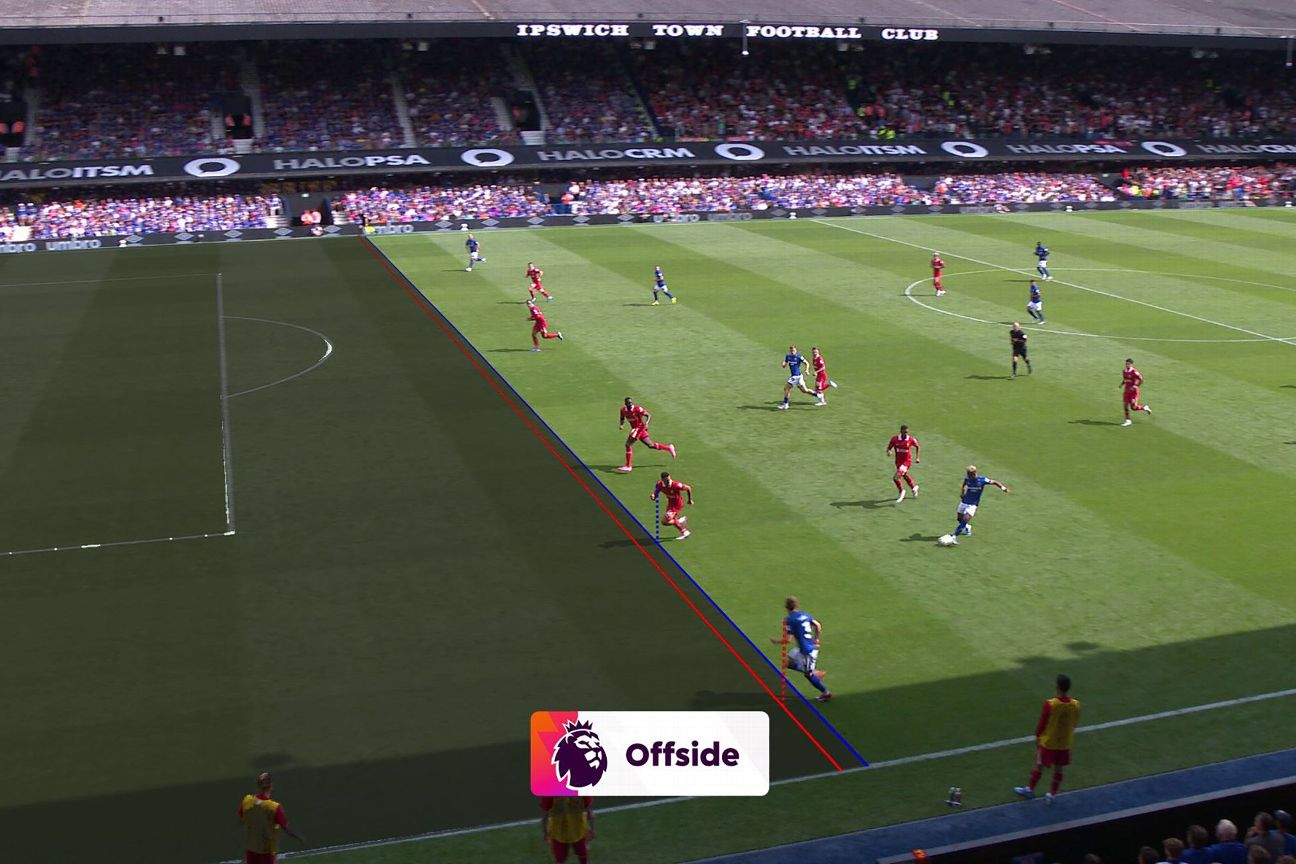[ad_1]
Video Assistant Referee causes controversy every week in the Premier League, but how are decisions made, and are they correct?
After each weekend we take a look at the major incidents, to examine and explain the process both in terms of VAR protocol and the Laws of the Game.
In this week’s VAR Review: Should Yerson Mosquera have been sent off for grabbing Kai Havertz by the throat? Why was Everton’s penalty overturned against Brighton & Hove Albion? And what about the goal Eberechi Eze thought he’d scored?
Possible red card: Violent conduct by Mosquera
What happened: Yerson Mosquera tussled with Kai Havertz in the 55th minute, and as the Wolverhampton Wanderers defender fell to the ground he landed with his hand on his opponent’s throat. Mosquera immediately raised his other arm in apology, and referee Jarred Gillett took no action.
VAR decision: No red card.
VAR review: It looks really bad when you look at the image but the VAR, Paul Tierney, is taking into account a few things before deciding if the referee has missed a red card (remember he cannot say it should have been a yellow.)
The context of the situation, e.g. a player is falling and has to put his hand somewhere, is important. That doesn’t of course prevent the VAR from deciding Mosquera knew exactly what he was doing, and deeming it violent conduct. Yet that’s also why the VAR will have doubts about it.
Did Mosquera raise his other arm because it was a mistake, or had he realised he’d done wrong and wanted to get out of trouble? It’s difficult for the VAR to be certain it was violent conduct, so a VAR review for a red card would be unlikely.
Mosquera got into trouble again in the 88th minute when grabbed Gabriel Jesus’ backside to move him out of the way of the ball for a free kick. The Wolves player was likely trying to wind up Jesus, who was actually booked for his angry reaction, but there’s no red-card situation for the VAR.
Possible penalty overturn: Dunk challenge on Calvert-Lewin
What happened: Referee Simon Hooper pointed to the penalty spot in the 47th minute, believing that Dominic Calvert-Lewin had been fouled by Lewis Dunk. However, the VAR, Darren England, sent Hooper to the monitor to overturn his decision.
VAR decision: Penalty cancelled.
VAR review: We’re going to hear a lot of discussion about the high bar in the coming weeks and two penalty decisions on the opening weekend — the other being West Ham’s — showed how perception and practice are two different things.
Much of the coverage has talked about a “higher bar,” yet that isn’t the case. Howard Webb, the Premier League’s chief refereeing officer, was seeking to reaffirm the high bar that exists in his preseason briefings, rather than say the threshold for intervention had been raised.
Perhaps the message got mixed up in the move to use “referee’s call” over “clear and obvious,” and the drive to make VAR quicker and more efficient. Both are part of the six-point plan to improve VAR.
The bar remains in the same place as last season: high with the intention of only intervening when something jumps out. “Referee’s call” is supposed to help fans understand it’s the official in the middle who is in control, rather than the video assistant.
Being less forensic over reviews has been taken to mean there will be fewer interventions, but the Premier League already has the lowest rate in the top five leagues (0.29 per game). Not over-analysing applies both to the VAR intervening and when they don’t; it’s about being quicker and more confident, not raising a bar. For instance, a VAR might have spent three minutes on a review last season and decided not to advise a penalty: reducing that time is about making a faster, but still accurate decision, not a raised bar.
Indeed, the Premier League has a bigger problem with missed interventions, rather than getting involved too much.
Everton manager Sean Dyche was unhappy after the game, and he too referred to there being a “very high bar” this season, so it’s been misunderstood among the clubs as well as the media, and that feeds through to the fans.
But Dyche can have no complaints here; it’s an example of VAR working well. Dunk slides in and attempts to make a block with his right leg, with his left on the ground tucked in. Calvert-Lewin then stands on Dunk’s left foot, which causes the striker to go to ground. Hooper believes the Everton player has had his foot swept away, but there isn’t really a tackle.
If Dunk had been challenging into Calvert-Lewin and the momentum carried him into Calvert-Lewin’s path, then the decision would have stayed on-field.
There was speculation on social media that Hooper hadn’t even looked at this incident on the screen. However, the main VAR screen wasn’t working which made it look like Hooper was staring at a frozen VAR screen.
But there’s always a back-up monitor on the ground within a case which a referee can use. So while it might have seemed that Hooper wasn’t looking, he was watching a different screen on the floor.
Possible penalty overturn: Cash challenge on Soucek
What happened: West Ham United were awarded a penalty in the 35th minute when Tomás Soucek was bundled over by Matty Cash, with referee Tony Harrington pointing to the spot. It looked a little soft and was checked by the VAR, John Brooks.
VAR decision: Penalty stands, scored by Lucas Paquetá.
VAR review: The penalties which are given on-field, but wouldn’t be through VAR alone, are always controversial; they are the soft spot kicks which infuriate people. Some fans felt this was an example of a “higher bar”? After all Cash did get a toe to the ball.
The VAR felt that although Cash got a small touch that wasn’t enough to override the nature of the challenge itself, with Cash having to reach round Soucek and then bring him down.
Webb ran through a series of penalties that were soft last season where the VAR didn’t intervene, and insisted the calls were correct: while open to debate they shouldn’t be considered clear and obvious errors. This falls into the same category — not a higher bar, just not enough reason to overturn the on-field decision.
Possible overturn: Schär red card
What happened: Fabian Schär was shown a red card by referee Craig Pawson in the 28th minute after a clash with Ben Brereton Díaz. As the two players squared up, the Newcastle United defender was adjudged to have moved his head into Brereton Díaz’s and was dismissed for violent conduct.
VAR decision: Red card stands.
VAR review: Once the VAR, Chris Kavanagh, has identified that Schär directed his head into the opponent’s there no likelihood of a VAR intervention.
We can certainly question Brereton Díaz’s actions, because the Southampton player theatrically threw himself to the ground. He was booked for his part in the tussle but wouldn’t get another caution for simulation when the opponent has been sent off.
Possible goal by Eze
What happened: Eberechi Eze thought he had given Crystal Palace the lead in the 26th minute when he caught out Brentford goalkeeper Mark Flekken with a shot from a long-distance free kick, when it looked like he would play in a cross. However, referee Sam Barrott blew his whistle before the ball entered the goal for a foul by Will Hughes on Nathan Collins.
VAR decision: No intervention possible.
VAR review: Play is dead as soon as the referee blows his whistle to stop play. Once the VAR has checked that this happened before the ball crossed the line, meaning there was never a goal to review, there’s no role for the VAR.
Eze caught out both the goalkeeper and referee Barrott, in his first game since being permanently promoted to the Premier League’s Select Group 1 list. Barrott was one of the most impressive officials last season, and this is just one of those situations that happens from time to time.
If the referee had realised Eze was shooting, he would surely have held his whistle until the ball went in. That he blew up earlier, watching the players on the edge of the box, shows he must have thought Eze had crossed the ball rather than taking a shot.
If the referee had allowed the ball to cross the line before blowing his whistle, the VAR could have reviewed the foul on the edge of the box.
Possible penalty: Challenge by Iwobi / Robinson on Amad
What happened: The game was in the 13th minute when Amad broke into the area and went to ground under pressure from Alex Iwobi and Antonee Robinson. Referee Robert Jones waved away the penalty claims and Fulham broke up the other end, with Kenny Tete seeing his shot saved by André Onana.
VAR decision: No penalty.
VAR review: No chance of a penalty kick for this situation. Neither Iwobi or Robinson appeared to make any kind of challenge, and if anything Amad attempted to place his leg in to gain contact.
Had Fulham scored on the break and the VAR then identified a penalty, the goal would have been disallowed with the game restarting with Man United’s spot kick.
Possible penalty: Challenge by Smith Rowe on Maguire
What happened: Harry Maguire was booked by referee Jones in the 40th minute when he went down looking for a penalty for contact from Fulham debutant Emile Smith Rowe. The VAR, Jarred Gillett, checked for a possible penalty.
VAR decision: No penalty.
VAR review: Maguire went down very easily when he saw the challenge from Smith Rowe coming in. Perhaps he was just anticipating it, but the former Arsenal midfielder actually withdrew his foot and if there was any contact at all it would have been very slight.
The referee can’t be told it wasn’t a dive and to cancel the yellow.
There are two ways the yellow can be rescinded, but both require the referee to go to the monitor and there can’t just be a review of the yellow.
The ref would have to go to the screen having been advised to give a penalty. Once there he is in charge of the outcome, so he can give a penalty and cancel the booking; or he can reject the penalty review but also decide there was no simulation and remove the yellow.
Possible penalty: No offside against Davis
What happened: It looked like Ipswich Town were going to be given the chance to take the lead in the 53rd minute when Liam Delap was pulled down, and referee Tim Robinson appeared to be considering pointing to the spot. But there was confusion with the assistant, who had delayed an offside flag against Leif Davis, then raised it, and then dropped it again before the penalty incident.
VAR decision: Offside, no penalty.
VAR review: Assistants are instructed not to raise the flag in close offside situations, holding it until the attacking momentum ends. In this case he kept it down initially, before raising it when the Ipswich player checked back inside. The assistant clearly felt that as Davis hadn’t put a cross in, or continued his forward run, the attacking phase had completed.
Yet control of the match remains with the referee, so even if the flag goes up play still continues until the whistle is blown. As Robinson allowed the play to develop, a penalty could have been awarded had the VAR found than Davis was in fact onside.

Possible penalty: Walton challenge on Diaz
What happened: Luis Díaz had a great chance to put Liverpool into the lead in the 55th minute but lifted a shot over the bar. There was then a collision with Ipswich Town goalkeeper Christian Walton, but was it enough for a penalty?
VAR decision: No penalty.
VAR review: On the first replay it looked as though Diaz had been taken out after releasing the shot and there might be a case for a spot kick. However, it turned out to be a quick check for the VAR, Stuart Attwell, as the rear camera showed it was a natural coming together between striker and goalkeeper.
It’s very rare that players get penalties after they have released a shot, especially when this involves the goalkeeper. It has to be a reckless act from the opposition player, and Walton’s actions didn’t come close to that category.
Possible penalty: Handball by Kovacic
What happened: Chelsea appealed for a penalty in the 77th minute when the ball struck the arm of Mateo Kovacic. Referee Anthony Taylor waved away the penalty appeals, with the VAR, Michael Salisbury, checking it.
VAR decision: No penalty.
VAR review: The Premier League has insisted there will be more consideration for a player’s natural body movement on handball this season, though the Kovacic example is unlikely to have been penalised last season either.
While the Manchester City player has one arm raised, the ball hits his elbow which is close into his chest, and the ball came from close proximity.
Some factual parts of this article include information provided by the Premier League and PGMOL.
[ad_2]











